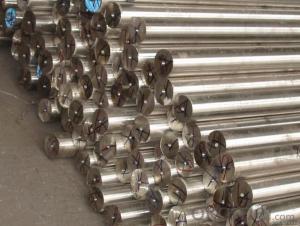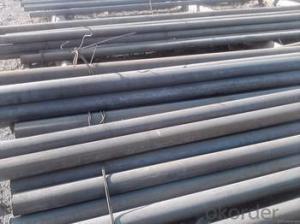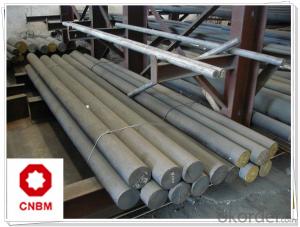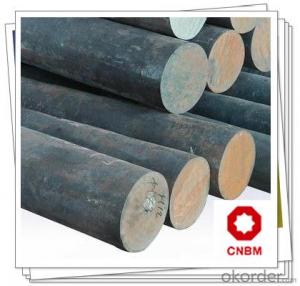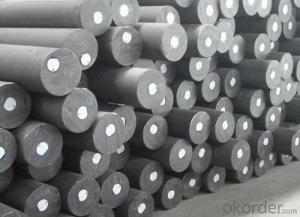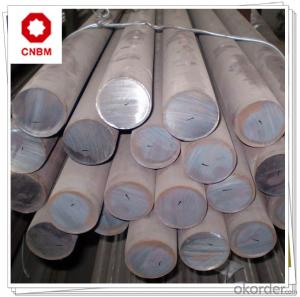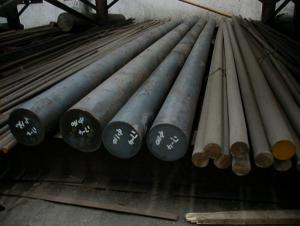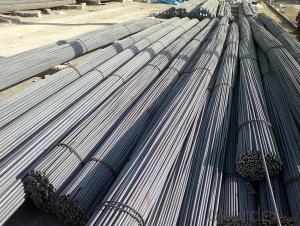Hot Rolled Steel Round Bar S20C
- Loading Port:
- Tianjin
- Payment Terms:
- TT OR LC
- Min Order Qty:
- 100 m.t.
- Supply Capability:
- 500000 m.t./month
OKorder Service Pledge
OKorder Financial Service
You Might Also Like
Specification
Hot Rolled Steel Round Bar S20C
Product Description of Hot Rolled Steel Round Bar S20C
1. Steel grade: SAE1020, 20#, C22, S20C
2. Length: 6M-12M
3. Diameter: 16mm-300mm
4. Product range: round bar, flat bar, square bar
5. Technique: Hot rolled, forged, cold drawn
Specification of Hot Rolled Steel Round Bar S20C
Material | S20C | Round bar | Dia(mm) | 16-300mm |
Process | EAF + LF + VD + Forged + Heat Treatment (optional) | Length (mm) | Max 12m | |
Heat treatment | Normalized / Annealed / Quenched / tempered | Flat bar | Thickness(mm) | 8-500mm |
Delivery condition | Hot forged +Rough machined (black surface after Q/T)+ Turned (optional) | Width(mm) | 70-200mm | |
Test | Ultrasonic test according to SEP 1921-84 D/d | Length (mm) | Max 12m |
Chemical Composition of Hot Rolled Steel Round Bar S20C
C | Si | Mn | Cr | Ni | Cu |
0.17~0.23 | 0.17~0.37 | 0.35~0.65 | ≤0.25 | ≤0.30 | ≤0.25 |
Photo Show of Hot Rolled Steel Round Bar S20C
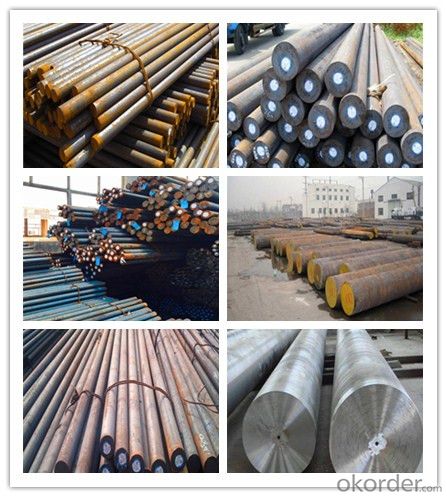
Packing and Delivery:
Packing in bundle package, or as customer's requirements.
Delivery Detail: 45 days after receiving the deposit.
Usage and Applications of Hot Rolled Steel Round Bar S20C
1. Steel round bar is used in a large number of architectural and engineering structures. Or it can be used in construction of plants for the production of steel house frames, high-voltage transmission towers, bridges, vehicles, boilers, containers, ships, etc.
2. And we can use this kind of product on the performance of the mechanical parts if the demand is not very high.
3. Some special material steel round bar can be used for main shaft of steamer, hummer shank, with big section and supper force.
Company Information
CNBM International Corporation is the most important trading platform of CNBM group.
Whith its advantages, CNBM International are mainly concentrate on Cement, Glass, Iron and Steel, Ceramics industries and devotes herself for supplying high qulity series of refractories as well as technical consultancies and logistics solutions.


F A Q
1, Your advantages?
professional products inquiry, products knowledge train (for agents), smooth goods delivery, excellent customer solution proposale
2, Test & Certificate?
SGS test is available, customer inspection before shipping is welcome, third party inspection is no problem
3, Factory or Trading Company?
CNBM is a trading company but we have so many protocol factories and CNBM works as a trading department of these factories. Also CNBM is the holding company of many factories.
4, Payment Terms?
30% TT as deposit and 70% before delivery.
Irrevocable L/C at sight.
5, Trading Terms?
EXW, FOB, CIF, FFR, CNF
6, After-sale Service?
CNBM provides the services and support you need for every step of our cooperation. We're the business partner you can trust.
For any problem, please kindly contact us at any your convenient time.
We'll reply you in our first priority within 24 hours.
- Q: Are steel round bars suitable for use in the automotive industry?
- Yes, steel round bars are commonly used in the automotive industry due to their strength, durability, and versatility. They are used in various applications such as axle shafts, drive shafts, suspension components, and engine parts. The high tensile strength and resistance to wear make steel round bars ideal for handling heavy loads and enduring demanding conditions in vehicles.
- Q: Why is a steel rope made of many wires rather than a round bar of steel?
- It is a strand of steel that bends more easily. In general, but the tensile strength is still a single good, but many shares of a broken, will soon be found, easy to change in time, or a broken, immediately out of the accident.
- Q: What are the different surface treatments available for stainless steel round bars?
- There are several surface treatments available for stainless steel round bars to enhance their appearance, improve corrosion resistance, and provide added protection. Some of the common surface treatments for stainless steel round bars include: 1. Pickling: This process involves removing any surface impurities or oxides by immersing the stainless steel bar in an acid solution. Pickling helps to restore the stainless steel's natural corrosion resistance and creates a smooth and clean surface. 2. Passivation: Passivation is a chemical treatment that forms a thin, protective layer on the surface of stainless steel. By removing free iron and other contaminants, passivation helps to enhance the stainless steel's resistance to corrosion. 3. Electropolishing: This treatment involves applying an electric current to the stainless steel round bar while immersed in an electrolyte solution. Electropolishing removes a thin layer of material from the surface, resulting in a smooth, shiny, and corrosion-resistant finish. 4. Grinding and Polishing: Grinding and polishing are mechanical processes used to improve the surface finish of stainless steel round bars. Grinding involves removing any imperfections or roughness, while polishing creates a smooth and reflective surface. 5. Coating: Coating stainless steel round bars with a protective layer can provide additional corrosion resistance. Common coatings include electroplating with zinc or nickel, as well as applying organic coatings like paints or powder coatings. 6. Shot blasting: This treatment involves bombarding the stainless steel round bar's surface with small metallic or non-metallic particles at high velocity. Shot blasting removes any surface contaminants, scales, or oxides, resulting in a clean and textured surface. It is important to note that the choice of surface treatment depends on the desired end-use application, as well as the specific requirements for appearance and corrosion resistance. Consulting with a professional or manufacturer can help determine the most suitable surface treatment for stainless steel round bars.
- Q: Q235 and mechanical properties of hot rolled steel cold drawn steel have what difference, Q235 hot rolled steel with 12 combined shearing machine has a number of very hard, the damage of the blades, why
- The difference between hot rolled steel and cold rolled steelHot rolled steel contains slightly higher carbon content than cold rolled steel. The density is the same in cases where the composition is not constant. But if the composition is different, such as stainless steel, whether cold-rolled or hot rolled steel, the density is about 7.9g/cm3. Specific depends on the ingredients, hot-rolled steel plate is only better ductility, steel is also under pressure.Hot-rolled steel is divided into structural steel, low carbon steel, welding bottle steel, and then according to various kinds of steel to find the steel that you need, check the density and composition of the specific steel.Hot rolled steel is low in hardness, easy to process and good in ductility.
- Q: What are the properties of steel round bars?
- Steel round bars have several properties that make them highly desirable for a wide range of applications. Firstly, they possess exceptional strength and durability, making them suitable for load-bearing structures and heavy-duty machinery. Additionally, steel round bars exhibit excellent corrosion resistance, allowing them to withstand harsh environmental conditions without compromising their integrity. They also have a high melting point and can withstand extreme temperatures, making them ideal for applications that involve heat or fire. Furthermore, steel round bars can be easily machined, welded, and fabricated, providing flexibility in design and construction processes. Lastly, they offer good dimensional stability and precise tolerances, ensuring consistent performance and reliability in various industrial and construction settings.
- Q: Can steel round bars be used for making sculptures?
- Yes, steel round bars can be used for making sculptures. Steel is a versatile and durable material that can be manipulated into various forms and shapes. Round bars are particularly suitable for creating sculptures that require a smooth and curved aesthetic. Steel sculptures are known for their strength, longevity, and ability to withstand different weather conditions, making them suitable for both indoor and outdoor installations. Additionally, steel can be welded, bent, and shaped easily, allowing artists to explore their creativity and create intricate designs. With proper techniques and skills, steel round bars can be transformed into stunning sculptures that can add a modern and industrial touch to any space.
- Q: What is the thermal conductivity of a steel round bar?
- The thermal conductivity of a steel round bar may differ based on the particular steel type and composition. In general, carbon steel exhibits a thermal conductivity range of 26 to 48 W/m·K, whereas stainless steel typically has a slightly lower thermal conductivity of 15 to 27 W/m·K. Nevertheless, these values are only approximations and can be influenced by factors including temperature, impurities, and alloying elements. It is worth noting that thermal conductivity describes a material's capacity to conduct heat and is commonly measured in units of W/m·K.
- Q: What are the different grades of steel round bars?
- The different grades of steel round bars include mild steel, carbon steel, alloy steel, and stainless steel.
- Q: What are the advantages of using titanium-alloy steel round bars?
- The advantages of using titanium-alloy steel round bars include their exceptional strength-to-weight ratio, excellent corrosion resistance, and high temperature resistance. Additionally, titanium-alloy steel round bars offer improved durability, better fatigue resistance, and are suitable for various industries such as aerospace, automotive, and medical, where lightweight and high-performance materials are required.
- Q: Can steel round bars be used in the manufacturing of household appliances?
- Household appliances can indeed make use of steel round bars. Steel, being a versatile and durable material, is widely employed in a variety of industries, including the manufacturing of appliances for homes. The construction of appliance frames, support structures, and even internal components can all benefit from the utilization of steel round bars. Its high strength and resistance to corrosion make steel an excellent choice for ensuring the longevity and durability of household appliances. Moreover, steel can be easily molded and shaped to precise dimensions, allowing for the creation of appliances with intricate designs. In summary, incorporating steel round bars into the manufacturing process of household appliances helps to produce products that are of superior quality, reliability, and longevity.
Send your message to us
Hot Rolled Steel Round Bar S20C
- Loading Port:
- Tianjin
- Payment Terms:
- TT OR LC
- Min Order Qty:
- 100 m.t.
- Supply Capability:
- 500000 m.t./month
OKorder Service Pledge
OKorder Financial Service
Similar products
Hot products
Hot Searches
Related keywords















